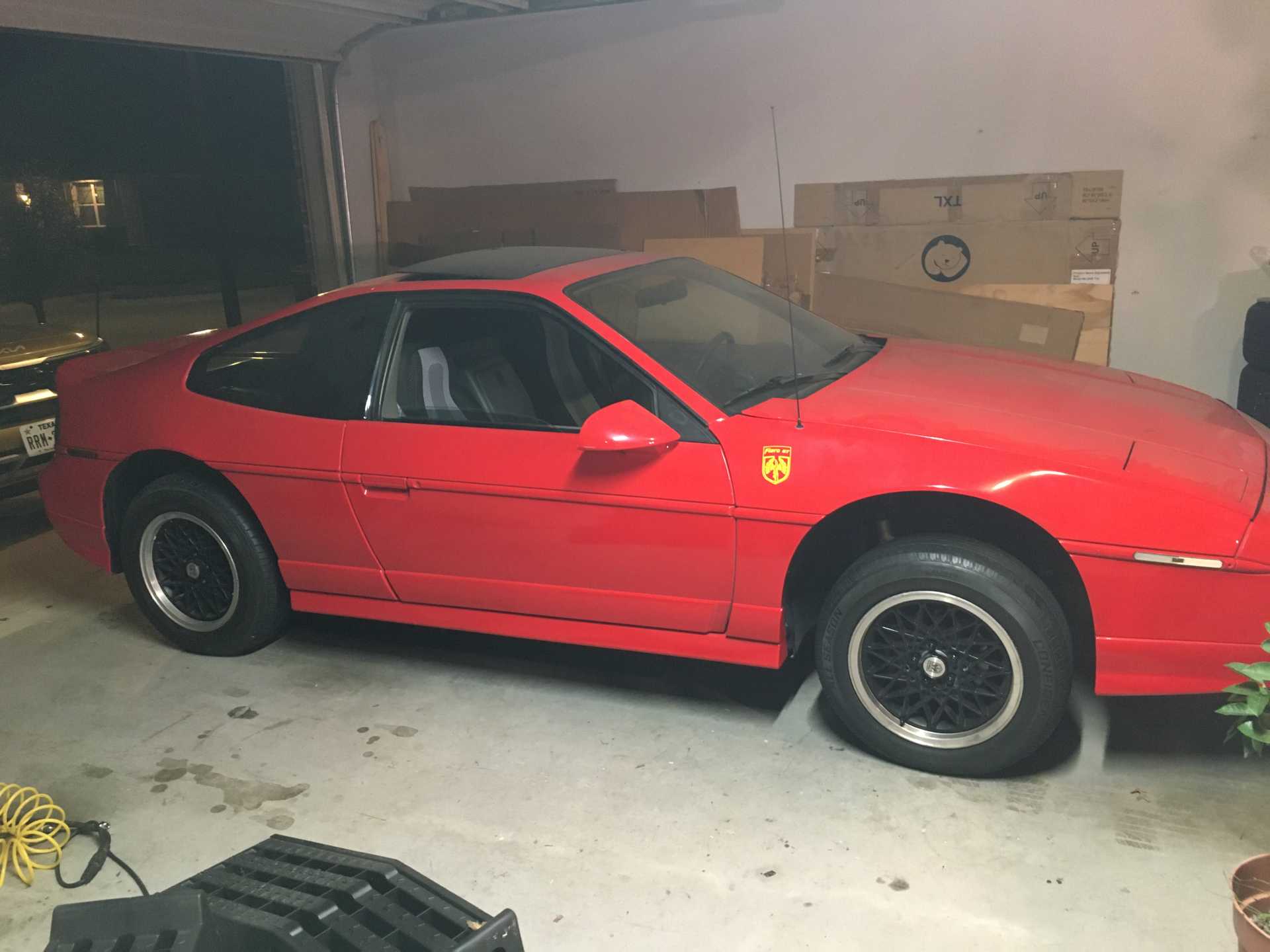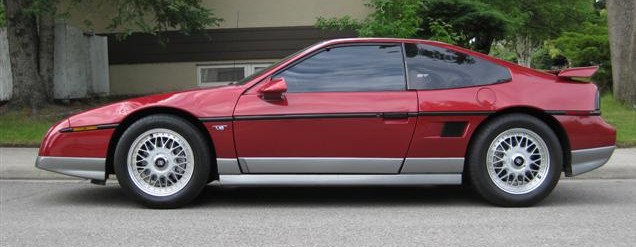 
     |
| looking for help figuring out what went wrong with front coil spring replacement (Page 1/2) |

|
Signupacct
|
MAR 17, 04:34 PM
|
|
I purchased a 1987 Pontiac Fiero GT V6 recently. It had been lowered by the seller. I have been trying to get it back to oem regarding front coil springs and clearance.
Following a significant amount of phone time and research to identify replacement coil springs that would restore it back to oem, I purchased RC6730 springs through Husky Springs, elsewhere referred to as SMS6730. The specs are as follows: 13.56 inch height out of the box, .05 inch diameter coil wire, 3.4 inch I.D., 9 coil winds, 755 lbs. weight rating.
I also replaced the upper and lower bushings and had The Fiero Store powder coat and install new ball joints along with the new bushings. The bump stops were reduced, by previous owner, by an inch according to overall bumpstop height information from this forum in a different post. So an inch was added back to the lower control arm, in the process of replacing the front coil springs, so the bump stop would hit at approximately the same point as before the car was lowered.
I torqued all the bolts accord to the factory manual. However, the car is now much higher in the front than before and it appears significantly higher than it should be oem.See attached pics.



there is by tape measure 10 inches between ground and side panel or rocker panel and there is 6 1/4 inches between top of front wheel and the opening of the fender. Online resources quoting Pontiac factory service manual reference the ground clearance at 4.3 inches.
And that the wheel to fender gap should be 2.1 inches for the front and 2.5 inches for the rear. When I put the weight of my body , by placing the palms of my hands on the fender and pushing down I dont see the suspension yielding any.
Does anyone know what the oem front coil spring part number is for 87 Fiero GT V6 with A/C? Does anyone know the weight rating or specification for the oem springs for the 1987 Pontiac Fiero GT V6 with aair conditioning. I just want the car back to oem ride height and suspension performance.
Suitability analysis of part number RC6730 and a rating of 755 lbs. is as follows: My references indicate the 1987 Pontiac Fiero GT V6 is about 2940 lbs. with a weight ratio of 52%(rear) 48%(front). 48 percent of 2940 lbs. is 1411.20 lbs and half of that is 705 lbs per side. In some documentation it was said that slighly stiffer springs were put in in 1987 to address body roll and to improve handling. So if the RC6730 is rated at 755 that could conceiveably mean that these are close enough to oem or what was put on the car at the factory.
Some have mentioned that torqueing the lower and upper control arms with wheels fully extended on a hydraulic jack and then letting it down off the jack may be the source of the problem. that those bolts should be tightened and torqued while suspension is bearing the weight of the front end. I am also told that springs will not be expected to settle more than a 1/2 or so after driving it a bit. It would appear that 3 to 4 inches of settling would be needed.
Thoughts, suggestions, feedback and answers to the questions posted above would be greatly appreciated. And yes I have read archived posts, including references to Chevette springs, however I have not found any posting where after replacing the front coil springs as I have resulted in what appears to be a front suspension that is fully extended and riding at the top of its travel.
Joe k
|
|

|
Tha Driver
|
MAR 17, 04:43 PM
|
|
Did you use rubber control arm bushings? If so, you have to tighten them with weight on the car. If you tighten them with the control arm at full drop, they will hold the car up.
HTH,
~ Paul
aka "Tha Driver"
|
|

|
Signupacct
|
MAR 17, 05:47 PM
|
|
yes
I used rubber bushings and yes I tightened them while fully extended
ok
so what is the proper protocol then
put hydraulic jack underneath lower control arm and tighten to torque spec ?
then lower off jack ?
if the tightening makes the lower control arm stay up will tightening when under load hold it down so it will not extend upward if needed ?
and if so is that ok and for how long will it stay that way, so stiff the suspension does not easily travel
Joe k
|
|

|
fieroguru
|
MAR 17, 06:08 PM
|
|
Two most common reasons....
1. Bottom end of the spring is not in the recessed pocket on the lower control are.
2. Torquing the control arm bushings at full droop. Rest the wheels on blocks under weight and tighten the bushing bolts.
|
|

|
fierosound
|
MAR 18, 07:53 AM
|
|
I think the problem is the 755# spring rating (too stiff).
Does the car move at all when you throw your body on it?
I needed to raise my front a bit too because I had 1-inch lowering spindles AND the old springs were worn out.
The problem was fixed with NEW Chevette springs which were still available.
https://www.fiero.nl/forum/...120111-2-110255.html

------------------
My World of Wheels Winners (Click on links below)

3.4L Supercharged 87 GT and Super Duty 4 Indy #163[This message has been edited by fierosound (edited 03-20-2023).]
|
|

|
fieroguru
|
MAR 18, 09:03 AM
|
|
|
Pretty sure the 755 lbs is the load rating not the spring rate. I doubt they could be installed with a 755 lb/in spring rate.
|
|

|
fierosound
|
MAR 18, 09:27 AM
|
|
| quote | Originally posted by fieroguru:
Pretty sure the 755 lbs is the load rating not the spring rate. I doubt they could be installed with a 755 lb/in spring rate. |
|
Gotcha. I missed the load vs rate...
Also, not clear on the modification to lower control arm he mentions...
| quote | Originally posted by Signupacct:
he bump stops were reduced, by previous owner, by an inch according to overall bumpstop height information from this forum in a different post. So an inch was added back to the lower control arm, in the process of replacing the front coil springs, so the bump stop would hit at approximately the same point as before the car was lowered.
|
|
[This message has been edited by fierosound (edited 03-18-2023).]
|
|

|
Signupacct
|
MAR 19, 10:49 PM
|
|
ok
I realize that I was not as specific as I needed to be in regards to modifications to the lower control arm to make up for the reduction in the bump stop cone. By consulting the forum in regards to oem bump stop height it was determined that 1 inch was removed and then cone rewelded and the rubber stop was in place as before. So I took a stack of fender washers and I drilled a hole in the lower control arm in the center of where the spring is cradled. I used a aircraft or nylox stainless steel nut on a stainless steel bolt. It is positioned right in the center of where the bump stop would hit. So there is a stack of 1 inch high stack of fender washers in the center of the lower control arm where the spring is cradled. The bump stop would come down and hit the washer stack an inch earlier which would make up for the bump stop cone being an inch shorter.
This solution seemed better than trying to reweld the shortened bump stop back to oem height while in place or remove it and reweld it and re install or find oem bump stops and remove the shortened ones and install oem's
If I can find my pics of this I will post later, can't easily find them at the moment[This message has been edited by Signupacct (edited 03-19-2023).]
|
|

|
Signupacct
|
MAR 19, 11:11 PM
|
|
here are the numbers related to the RC6730 springs that were recommended by the engineer for the vendor.
SMS6730 187.5 / 755 9.63 / 13.56
13.5 inches high uninstalled
half inch radius rod to make coil
3.4 inch inside diameter
9 coil winds
as for other springs that were discussed before the RC6730 was decided and sent
SMS6556 197 / 808 9.63 / 13.75
SMS6558 197 / 861 9.63 / 14.06
I believe the last number is the height uninstalled and 9.63 is installed ? maybe
|
|

|
Rick Vanderpool
|
MAR 19, 11:11 PM
|
|
|
Looking at the specs of the spring you listed it has a spring rate of 1501 lb/in. That means that it would only compress 1/2 inch when you put the weight on it, based on the car weight calculated. It is way too stiff.
|
|
    
  |















